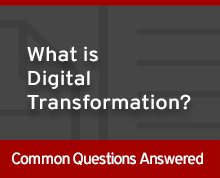As digital transformation continues at a rapid pace, CIOs must grapple with changes on a number of fronts, including new players vying for technical relevancy within their organization, a rethinking of IT structure, and whether an outsourcing model is still viable.
These are just a few of the challenges that Ravi Kalakota sees from his position as partner and CTO of LiquidHub, an IT consulting company that helps clients with systems integration.
“Digital transformation is really a CEO or even a board level priority,” Kalakota says, noting that companies in verticals such as retail and banking have no choice but to embrace it. “If people are not focused on millennials and converting to digital rapidly, they’re dead.”
Marketing is driving the digital bus
 In many cases, it’s the marketing department driving digital initiatives; in some cases building a shadow IT group in the process to help them deliver, up to a point. Companies such as Salesforce.com, for example, target marketing or sales groups, not IT, Kalakota says. “There are about 1,800 products right now in the marketing technology arena,” he notes.
In many cases, it’s the marketing department driving digital initiatives; in some cases building a shadow IT group in the process to help them deliver, up to a point. Companies such as Salesforce.com, for example, target marketing or sales groups, not IT, Kalakota says. “There are about 1,800 products right now in the marketing technology arena,” he notes.
Marketing groups are also taking on employees who are skilled in digital technologies. “A vast new frontier is emerging around digital talent and where it resides within the organization. That’s becoming a new angle of the digital transformation story,” Kalakota says.
In many cases, marketing is good at generating innovative ideas and they want to get them to market fast – far more quickly than IT is used to. So they build up just enough IT know-how to come up with prototypes they can test with a small sample of customers.
But when it comes time to scale the initiative, it shifts back to the realm of IT and the CIO. To make it a real product, the initiative has to be integrated with enterprise operations and, most likely, deployed in a cloud model, or hybrid public/private cloud. “Those sort of things is really what the CIO talent needs to be good at,” he says.
Emergence of the CDO
Clearly such a situation cries out for tight integration between the marketing and IT groups. To help facilitate that, the role of chief digital officer is taking shape.
“The CDO is an intermediary between the CMO and CIO, playing an alignment role,” Kalakota says.
CDOs are primarily focused on front office initiatives that directly touch the customer, including sales, marketing, channels and service. In many cases, they work with outside IT service providers to help marketing quickly deliver on projects.
Rethinking outsourcing
While CDOs and marketing may be looking to service providers for help with technology projects, IT is rethinking its outsourcing strategy, Kalakota says.
“In the last decade IT has moved aggressively to a low cost delivery model with a lot of offshore outsourcing. The challenge is that model is set up for low cost delivery, not for fast delivery,” he says.
He’s now seeing a trend where companies are pulling those offshore resources back in-house and hiring internal staff again. But the skill sets they’re looking for have changed dramatically. Whereas once it was all Java and .Net, now companies need IT people who know their way around cloud-based platforms like Microsoft Azure that come with tools intended to support rapid application development.
“With the right framework you can speed up development by 30 to 50 percent,” he says. The problem is, all that legacy infrastructure doesn’t go away overnight, so IT still needs folks skilled in Java, .Net and all the rest. CIOs also have to decide whether to retrain their existing staff for these new platforms or just hire people who are already trained. It’s a tough question with no easy answers, Kalakota says.
Deconstructing IT groups
Ultimately, he thinks CIOs will have to essentially tear apart their large, centralized organizations and shift IT talent into functional groups like marketing and sales.
“In the quest for speed, companies will move IT closer to the functional groups, and embed IT into the function,” Kalakota says. “These large IT groups with thousands of people will get chipped away. That is going to happen.”
It may not happen for all companies all at once, however. Industries such as healthcare and finance, for example, are regulated and thus face limits on how quickly they can change – simply because they have to comply with those regulations.
“But non-regulated companies like Internet firms or retail, they’re moving incredibly fast,” he says.
Time to take stock of where your IT organization stands and assess the changes you may need to make in order to keep up with the digital tsunami.




